Ontogenetic Variation and Sexual Dimorphism of Beaks among Four Cephalopod Species Based on Geometric Morphometrics
Abstract
Simple Summary
Abstract
1. Introduction
2. Materials and Methods
2.1. Specimens
2.2. Data Acquisition
2.3. Geometric Morphometrics Analysis
3. Results
3.1. Ontogenetic Variation
3.2. Sexual Dimorphism
4. Discussion
4.1. Ontogenetic Pattern of Beak Shape
4.2. Sexual Dimorphism of Beak Shape
4.3. Variations in the Size and Shape of Beaks
5. Conclusions
Author Contributions
Funding
Institutional Review Board Statement
Informed Consent Statement
Data Availability Statement
Acknowledgments
Conflicts of Interest
References
- Nyboer, E.A.; Chapman, L.J. Ontogenetic shifts in phenotype–environment associations in Nile perch, Lates niloticus (Perciformes: Latidae) from Lake Nabugabo, Uganda. Biol. J. Linn. Soc. 2013, 110, 449–465. [Google Scholar] [CrossRef]
- Adams, D.C.; Nistri, A. Ontogenetic convergence and evolution of foot morphology in European cave salamanders (Family: Plethodontidae). BMC Evol. Biol. 2010, 10, 216. [Google Scholar] [CrossRef]
- Marian, J.E.A.R.; Apostolico, L.H.; Chiao, C.C.; Hanlon, R.T.; Hirohashi, N.; Iwata, Y.; Mather, J.; Sato, N.; Shaw, P.W. Male Alternative Reproductive Tactics and Associated Evolution of Anatomical Characteristics in Loliginid Squid. Front. Physiol. 2019, 10, 1281. [Google Scholar] [CrossRef] [PubMed]
- Apostolico, L.H.; Marian, J.E. Cephalopod mating systems as models for the study of sexual selection and alternative reproductive tactics: A review. Bull. Mar. Sci. 2020, 96, 375–398. [Google Scholar] [CrossRef]
- Guo, H.; Zhang, D.; Näslund, J.; Wang, L.; Zhang, X. Effects of spawning group sex ratio and stocking density on the outcome of captive reproduction in golden cuttlefish Sepia esculenta. Aquaculture 2022, 559, 738416. [Google Scholar] [CrossRef]
- Guo, H.; Zhang, D.; Wang, L.; Li, W.; He, P.; Näslund, J.; Zhang, X. Sperm competition in golden cuttlefish Sepia esculenta: The impact of mating order and male size. Aquaculture 2020, 530, 735929. [Google Scholar] [CrossRef]
- Rohlf, F.J.; Marcus, L.F. A revolution in morphometrics. Trends Ecol. Evol. 1993, 8, 129–132. [Google Scholar] [CrossRef] [PubMed]
- Rohlf, F.J. Extensions of the Procrustes method for the optimal superimposition of landmarks. Syst. Biol. 1990, 39, 40–59. [Google Scholar] [CrossRef]
- Bookstein, F.L. Morphometric Tools for Landmark Data: Geometry and Biology; Cambridge University Press: Cambridge, UK, 1991. [Google Scholar]
- Adams, D.C.; Rohlf, F.J.; Slice, D.E. A field comes of age: Geometric morphometrics in the 21st century. Hystrix Ital. J. Mammal. 2013, 24, 7–14. [Google Scholar] [CrossRef]
- Rohlf, F.J. On applications of geometric morphometrics to studies of ontogeny and phylogeny. Syst. Biol. 1998, 47, 147–158. [Google Scholar] [CrossRef]
- Klingenberg, C.P. Evolution and development of shape: Integrating quantitative approaches. Nat. Rev. Genet. 2010, 11, 623–635. [Google Scholar] [CrossRef] [PubMed]
- Echeverry, A.M.; Londoño-Cruz, E.; Benítez, H.A. Quantifying the Geometric Shell Shape between Populations of True Limpets Lottia Mesoleuca (Mollusca: Lottidae) in Colombia. Animals 2020, 10, 675. [Google Scholar] [CrossRef]
- Slice, D.E. Landmark coordinates aligned by procrustes analysis do not lie in kendall’s shape space. Syst. Biol. 2001, 50, 141–149. [Google Scholar] [CrossRef] [PubMed]
- Fang, Z.; Chen, X.; Su, H.; Thompson, K.; Chen, Y. Evaluation of stock variation and sexual dimorphism of beak shape of neon flying squid, Ommastrephes bartramii, based on geometric morphometrics. Hydrobiologia 2017, 784, 367–380. [Google Scholar] [CrossRef]
- Kouttouki, S.; Georgakopoulou, E.; Kaspiris, P.; Divanach, P.; Koumoundouros, G. Shape ontogeny and variation in the sharpsnout seabream, Diplodus puntazzo (Cetti 1777). Aquac. Res. 2006, 37, 655–663. [Google Scholar] [CrossRef]
- Claverie, T.; Smith, I.P. Allometry and sexual dimorphism in the chela shape in the squat lobster Munida rugosa. Aquat. Biol. 2010, 8, 179–187. [Google Scholar] [CrossRef]
- Parvis, E.S.; Coleman, R.M. Sexual Dimorphism and Size–Related Changes in Body Shape in Tule Perch (Family: Embiotocidae), a Native California Live–Bearing Fish. Copeia 2020, 108, 12–18. [Google Scholar] [CrossRef]
- Jones, J.B.; Pierce, G.J.; Saborido-Rey, F.; Brickle, P.; Kuepper, F.C.; Shcherbich, Z.N.; Arkhipkin, A.I. Size-dependent change in body shape and its possible ecological role in the Patagonian squid (Doryteuthis gahi) in the Southwest Atlantic. Mar. Biol. 2019, 166, 54. [Google Scholar] [CrossRef]
- Liu, B.L.; Chen, X.J.; Wang, X.H.; Du, F.Y.; Fang, Z.; Xu, L.L. Geographic, intraspecific and sexual variation in beak morphology of purpleback flying squid (Sthenoteuthis oualaniensis) throughout its distribution range. Mar. Freshw. Res. 2019, 70, 417–425. [Google Scholar] [CrossRef]
- Hoving, H.J.T.; Perez, J.A.A.; Bolstad, K.S.; Braid, H.E.; Evans, A.B.; Fuchs, D.; Judkins, H.; Kelly, J.T.; Marian, J.E.; Nakajima, R.; et al. The Study of Deep-Sea Cephalopods. Adv. Cephalop. Sci. Biol. Ecol. Cultiv. Fish. 2014, 67, 235–359. [Google Scholar] [CrossRef]
- Clarke, M.R.; Maddock, L. The Mollusca Vol. 12. Paleontology and Neontology of Cephalopods; Academic Press: Cambridge, MA, USA, 1988; pp. 123–131. [Google Scholar]
- Dong, Z. Fauna of China Mollusca Cephalopoda; Science Press: Beijing, China, 1988. [Google Scholar]
- Arkhipkin, A.I.; Rodhouse, P.G.K.; Pierce, G.J.; Sauer, W.; Sakai, M.; Allcock, J.L.; Arguelles, J.R.; Bower, G.; Castillo, L.; Ceriola, C.S.; et al. World Squid Fisheries. Rev. Fish. Sci. Aquac. 2015, 23, 92–252. [Google Scholar] [CrossRef]
- Golikov, A.V.; Ceia, F.R.; Hoving, H.J.T.; Queirós, J.P.; Sabirov, R.M.; Blicher, M.E.; Larionova, A.M.; Walkusz, W.; Zakharov, D.V.; Xavier, J.C. Life History of the Arctic Squid Gonatus fabricii (Cephalopoda: Oegopsida) Reconstructed by Analysis of Individual Ontogenetic Stable Isotopic Trajectories. Animals 2022, 12, 3548. [Google Scholar] [CrossRef] [PubMed]
- Storero, L.P.; Ocampo-Reinaldo, M.; González, R.A.; Narvarte, M.A. Growth and life span of the small octopus Octopus tehuelchus in San Matias Gulf (Patagonia): Three decades of study. Mar. Biol. 2010, 157, 555–564. [Google Scholar] [CrossRef]
- Fang, Z.; Han, P.; Wang, Y.; Chen, Y.; Chen, X. Interannual variability of body size and beak morphology of the squid Ommastrephes bartramii in the North Pacific Ocean in the context of climate change. Hydrobiologia 2021, 848, 1295–1309. [Google Scholar] [CrossRef]
- Clarke, M.R. The identification of cephalopod “beaks” and the relationship between beak size and total body weight. Bull. Br. Mus. Nat. Hist. Zool. 1962, 8, 419–480. [Google Scholar] [CrossRef]
- Fang, Z.; Fan, J.; Chen, X.; Chen, Y. Beak identification of four dominant octopus species in the East China Sea based on traditional measurements and geometric morphometrics. Fish. Sci. 2018, 84, 975–985. [Google Scholar] [CrossRef]
- Pacheco-Ovando, R.; Granados-Amores, J.; González-Salinas, B.; Ruiz-Villegas, J.M.; Díaz-Santana-Iturrios, M. Beak shape analysis and its potential to recognize three loliginid squid species found in the northeastern Pacific. Mar. Biodivers. 2021, 51, 82. [Google Scholar] [CrossRef]
- Hobson, K.; Cherel, Y. Isotopic reconstruction of marine food webs using cephalopod beaks: New insight from captively raised Sepia officinalis. Can. J. Zool. 2006, 84, 766–770. [Google Scholar] [CrossRef]
- Fang, Z.; Thompson, K.; Jin, Y.; Chen, X.J.; Chen, Y. Preliminary analysis of beak stable isotopes (δ13C and δ15N) stock variation of neon flying squid, Ommastrephes bartramii, in the North Pacific Ocean. Fish. Res. 2016, 177, 153–163. [Google Scholar] [CrossRef]
- Crespi-Abril, A.C.; Morsan, E.M.; Barón, P.J. Analysis of the ontogenetic variation in body and beak shape of the Illex argentinus inner shelf spawning groups by geometric morphometrics. J. Mar. Biol. Assoc. U. K. 2010, 90, 547–553. [Google Scholar] [CrossRef]
- Brunetti, N.E.; Ivanovic, M.L.; Aubone, A.; Pascual, L.N. Reproductive biology of red squid (Ommastrephes bartramii) in the Southwest Atlantic. Rev. De Investig. Ny Desarro. Pesq. 2006, 18, 5–19. [Google Scholar]
- Bolstad, K.S. Sexual dimorphism in the beaks of Moroteuthisingens Smith, 1881 (Cephalopoda: Oegopsida: Onychoteuthidae). N. Z. J. Zool. 2006, 33, 317–327. [Google Scholar] [CrossRef]
- Norman, M.D.; Nabhitabhata, J.; Lu, C.C. An updated checklist of the cephalopods of the South China Sea. Raffles Bull. Zool. 2016, 34, 566–592. [Google Scholar]
- Boavida-Portugal, J.; Guilhaumon, F.; Rosa, R.; Araújo, M.B. Global patterns of coastal cephalopod diversity under climate change. Front. Mar. Sci. 2022, 8, 740781. [Google Scholar] [CrossRef]
- Xu, R.; Lü, Y.; Tang, Y.; Chen, Z.; Xu, C.; Zhang, X.; Zheng, X. DNA Barcoding Reveals High Hidden Species Diversity of Chinese Waters in the Cephalopoda. Front. Mar. Sci. 2022, 9, 830381. [Google Scholar] [CrossRef]
- Jin, Y.; Chen, X.J. Review on studies of Cephalopoda in the coastal waters of China. Mar. Fish. 2017, 39, 696–712. [Google Scholar] [CrossRef]
- Pang, Y.M.; Tian, Y.J.; Fu, C.H.; Wang, B.; Li, J.C.; Ren, Y.P.; Wan, R. Variability of coastal cephalopods in overexploited China Seas under climate change with implications on fisheries management. Fish. Res. 2018, 208, 22–33. [Google Scholar] [CrossRef]
- Zhao, C.X.; Shen, C.Y.; Bakun, A.; Yan, Y.R.; Kang, B. Purpleback flying squid Sthenoteuthis oualaniensis in the South China Sea: Growth, resources and association with the environment. Water 2020, 13, 65. [Google Scholar] [CrossRef]
- Arkhipkin, A.I. Reproductive System Structure, Development and Function in Cephalopods with a New General Scale for Maturity Stages. J. Northwest Atl. Fish. Sci. 1992, 12, 63–74. [Google Scholar] [CrossRef]
- Lipinski, M.R.; Underhill, L.G. Sexual maturation in squid: Quantum or continuum? S. Afr. J. Mar. Sci. 1995, 15, 207–223. [Google Scholar] [CrossRef]
- ICES. Report of the Workshop on Sexual Maturity Staging of Cephalopods; ICES: Livorno, Italy, 2010; pp. 1–97. [Google Scholar]
- Neige, P.; Dommergues, J.L. Disparity of beaks and statoliths of some coleoids: A morphometric approach to depict shape differentiation. Abh. Der Geol. Bundesanst. 2002, 57, 393–399. [Google Scholar]
- Gunz, P.; Mitteroecker, P. Semilandmarks: A method for quantifying curves and surfaces. Hystrix Ital. J. Mammal. 2013, 24, 103–109. [Google Scholar] [CrossRef]
- Rohlf, F.J. The tps series of software. Hystrix Ital. J. Mammal. 2015, 26, 9–12. [Google Scholar] [CrossRef]
- Adams, D.C.; Otárola-Castillo, E. Geomorph: An r package for the collection and analysis of geometric morphometric shape data. Methods Ecol. Evol. 2013, 4, 393–399. [Google Scholar] [CrossRef]
- Viscosi, V.; Cardini, A. Leaf morphology, taxonomy and geometric morphometrics: A simplified protocol for beginners. PLoS One 2011, 6, e25630. [Google Scholar] [CrossRef] [PubMed]
- Chen, X.J.; Fang, Z.; Chen, Y.; Su, H. Application of Geometric Morphometrics in Aquatic Animals; Science Press: Beijing, China, 2017. [Google Scholar]
- Adams, D.C.; Collyer, M.L. Multivariate Phylogenetic Comparative Methods: Evaluations, Comparisons, and Recommendations. Syst. Biol. 2018, 67, 14–31. [Google Scholar] [CrossRef]
- Claude, J. Morphometrics with R.; Springer: New York, NY, USA, 2008. [Google Scholar] [CrossRef]
- Chen, X.J.; Liu, B.L.; Wang, Y.G. Cephalopods of the World; Ocean Press: Beijing, China, 2009. [Google Scholar]
- Jonas, W.N.; Chen, W.; Wang, C.L.; Zhang, X.M.; Li, L.G.; Xu, J.C. Habit and Adaptability of Common Octopus variabilis to Certain Environmental Factors. Fish. Sci. 2010, 29, 74–78. [Google Scholar] [CrossRef]
- Li, N.; Fang, Z.; Chen, X.J. Fishery of swordtip squid Uroteuthis edulis: A review. J. Dalian Ocean. Univ. 2020, 35, 637–644. [Google Scholar] [CrossRef]
- Hanlon, R.T.; Messenger, J.B. Cephalopod Behaviour; Cambridge University Press: Cambridge, UK, 2018; pp. 74–96. [Google Scholar]
- Gao, X.D.; Fang, Z.; Chen, X.J.; Li, Y.K. Variation in beak morphology of Dosidicus gigas in different waters of the eastern equatorial Pacific. J/OL. Fish. China 2021. Available online: https://kns.cnki.net/kcms/detail/31.1283.s.20210528.1454.002.html. (accessed on 28 May 2021).
- Tanabe, K. The jaw apparatuses of Cretaceous desmoceratid ammonites. Palaeontology 1983, 26, 677–686. [Google Scholar]
- Kroger, B.; Vinther, J.; Fuchs, D. Cephalopod origin and evolution: A congruent picture emerging from fossils, development and molecules. Bioessays 2011, 33, 602–613. [Google Scholar] [CrossRef] [PubMed]
- Kear, A.J. Morphology and function of the mandibular muscles in some coleoid cephalopods. J. Mar. Biol. Assoc. U. K. 1994, 74, 801–822. [Google Scholar] [CrossRef]
- Uyeno, T.A.; Kier, W.M. Functional morphology of the cephalopod buccal mass: A novel joint type. J. Morphol. 2005, 264, 211–222. [Google Scholar] [CrossRef]
- Uyeno, T.A.; Kier, W.M. Electromyography of the buccal musculature of octopus (Octopus bimaculoides): A test of the function of the muscle articulation in support and movement. J. Exp. Biol. 2007, 210, 118–128. [Google Scholar] [CrossRef] [PubMed]
- Miserez, A.; Schneberk, T.; Sun, C.; Zok, F.W.; Waite, J.H. The transition from stiff to compliant materials in squid beaks. Science 2008, 319, 1816–1819. [Google Scholar] [CrossRef] [PubMed]
- Qian, Y.S. Studies on Ecological Habit and Artificial Reproductive Technique of Octopus minor; Ocean University of China: Qingdao, China, 2011. [Google Scholar]
- Wang, L.; Zhang, X.M.; Ding, P.W.; Liu, T.Y.; Chen, S.Q. Reproductive behavior and mating strategy of Sepia esculenta. Acta Ecol. Sin. 2017, 37, 1871–1880. [Google Scholar]
- Xie, J.Y.; Zhang, L.Z.; Wu, W.X.; Zhou, B.H.; Chen, Q.J.; Zhao, C.X.; He, X.B.; Xu, J.; Yan, Y.R. Feeding habit and trophic niche of purpleback flying squid (Sthenoteuthis oualaniensis) in the Nansha Islands area, South China Sea. J. Fish. China 2021, 45, 1993–2002. [Google Scholar]
- Castilla, A.C.; Hernández-Urcera, J.; Gouraguine, A.; Guerra, A.; Cabanellas-Reboredo, M. Predation behaviour of the European squid Loligo vulgaris. J. Ethol. 2020, 38, 311–322. [Google Scholar] [CrossRef]
- Roscian, M.; Herrel, A.; Zaharias, P.; Cornette, R.; Fernandez, V.; Kruta, I.; Cherel, Y.; Rouget, I. Every hooked beak is maintained by a prey: Ecological signal in cephalopod beak shape. Funct. Ecol. 2022, 36, 2015–2028. [Google Scholar] [CrossRef]
- Fang, Z.; Xu, L.; Chen, X.; Liu, B.; Li, J.; Chen, Y. Beak growth pattern of purpleback flying squid Sthenoteuthis oualaniensis in the eastern tropical Pacific equatorial waters. Fish. Sci. 2015, 81, 443–452. [Google Scholar] [CrossRef]
- Jin, Y.; Liu, B.L.; Chen, X.J.; Staples, K. Morphological beak differences of loliginid squid, Uroteuthis chinensis and Uroteuthis edulis, in the northern South China Sea. J. Oceanol. Limnol. 2018, 36, 559–571. [Google Scholar] [CrossRef]
- Jereb, P.; Roper, C.F.E. Cephalopods of the World. An Annotated and Illustrated Catalogue of Cephalopod Species Known to Date. Volume 1. Chambered Nautiluses and Sepioids (Nautilidae, Sepiidae, Sepiolidae, Sepiadariidae, Idiosepiidae and Spirulidae). Vol. 1. FAO Species Catalogue for Fishery Purposes. 4; FAO: Rome, Italy, 2005. [Google Scholar]
- Jereb, P.; Roper, C.F.E. Cephalopods of the World. An Annotated and Illustrated Catalogue of Cephalopod Species Known to Date. Volume 2. Myopsid and Oegopsid Squids. Vol. 2. FAO Species Catalogue for Fishery Purposes. 4; FAO: Rome, Italy, 2005. [Google Scholar]
- Iglesias, J.; Fuentes, L.; Villanueva, R. Cephalopod. Culture; Springer: New York, NY, USA, 2014; pp. 415–426. [Google Scholar] [CrossRef]
- Klingenberg, C.P. Size, shape, and form: Concepts of allometry in geometric morphometrics. Dev. Genes Evol. 2016, 226, 113–137. [Google Scholar] [CrossRef] [PubMed]
- Liu, M.N. Study on Morphology and Feeding Ecology of Chinese Squid (Uroteuthis chinensis); Shanghai Ocean University: Shanghai, China, 2020. [Google Scholar] [CrossRef]
- Ikica, Z.; Vuković, V.; Durović, M.; Joksimović, A.; Krstulovićšifner, S. Analysis of beak morphometry of the horned octopus Eledone cirrhosa, Lamarck 1798 (Cephalopoda: Octopoda), in the south–eastern Adriatic Sea. Acta Adriat. 2014, 55, 43–56. [Google Scholar]
- Von Boletzky, S. Origin of the lower jaw in cephalopods: A biting tissue. Palaeontol. Z. 2007, 81, 328–333. [Google Scholar] [CrossRef]

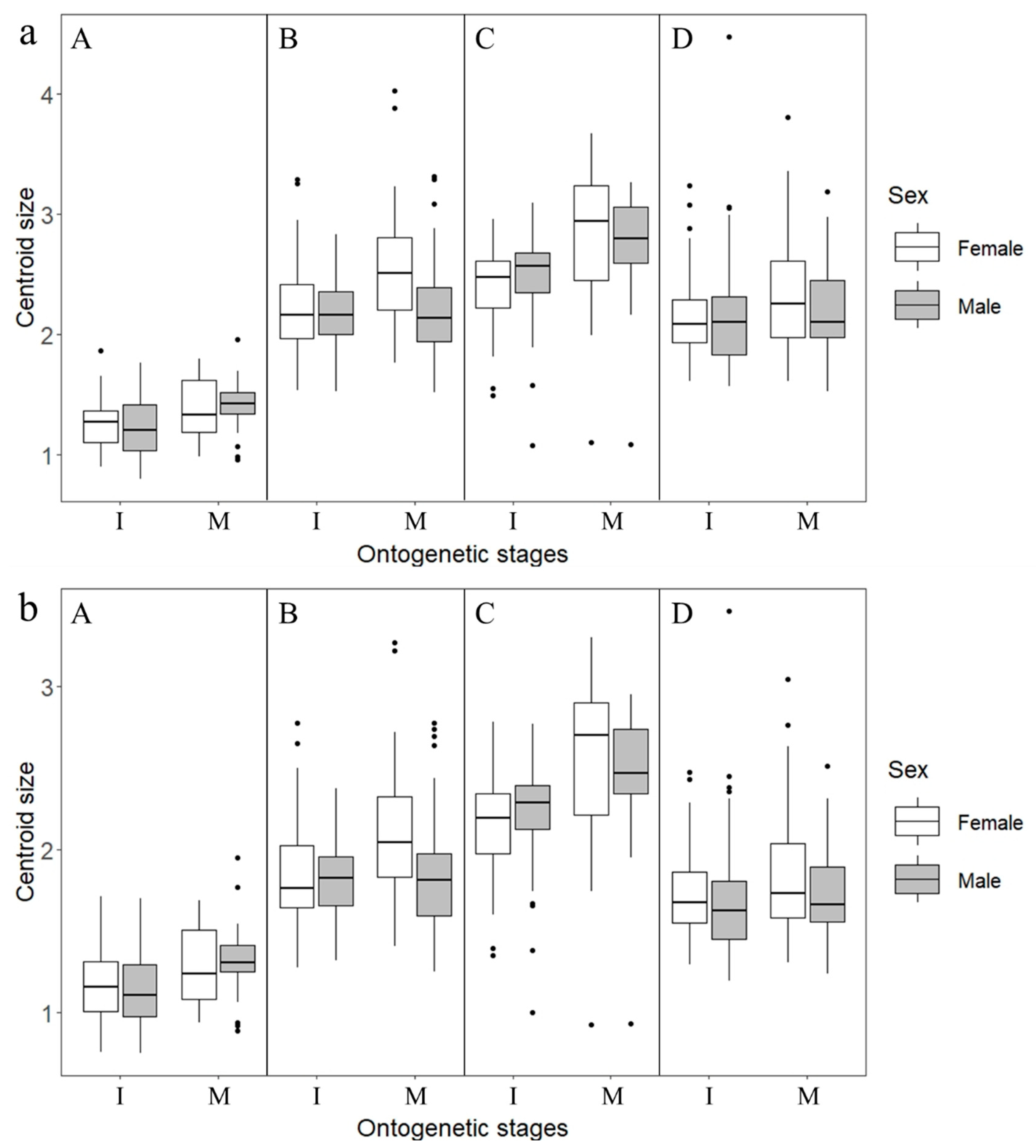
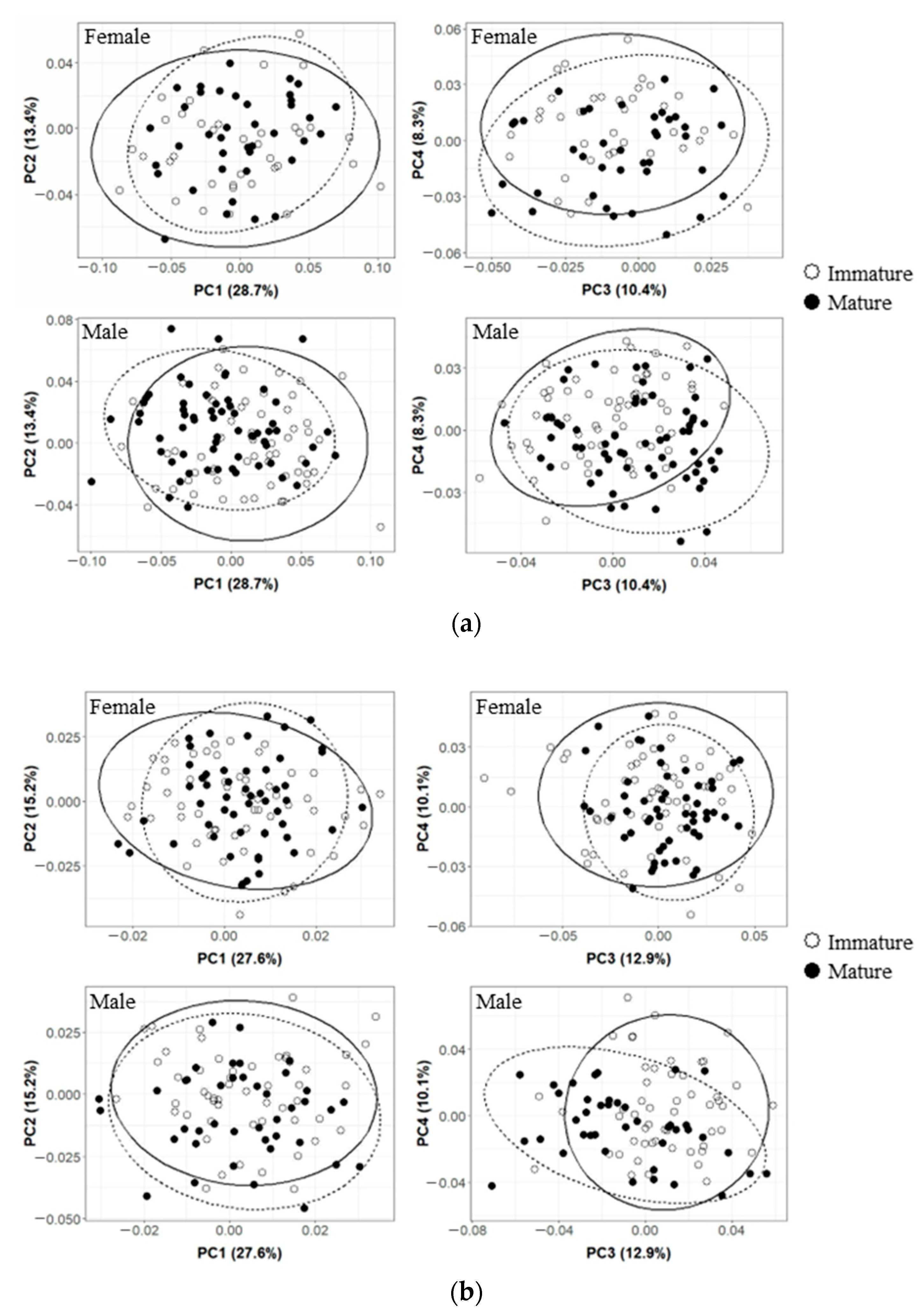

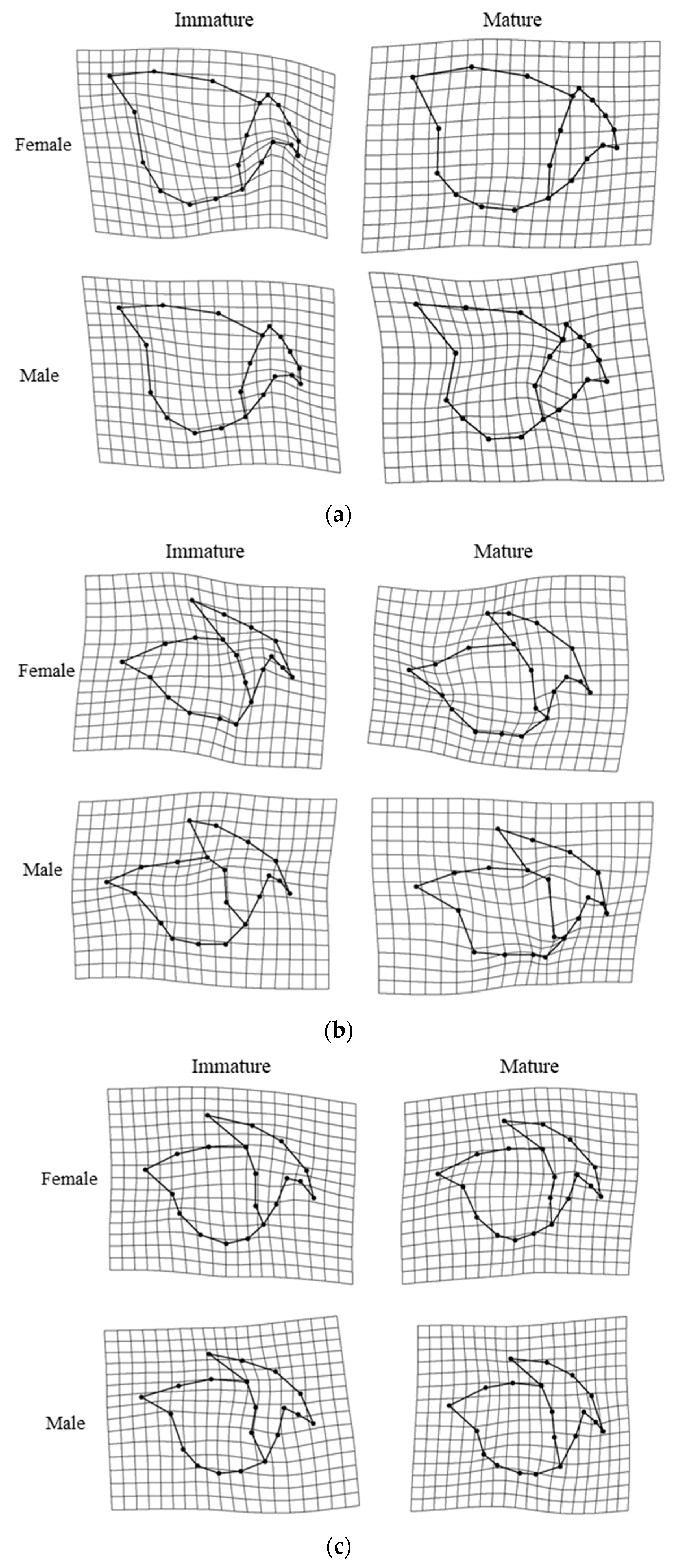

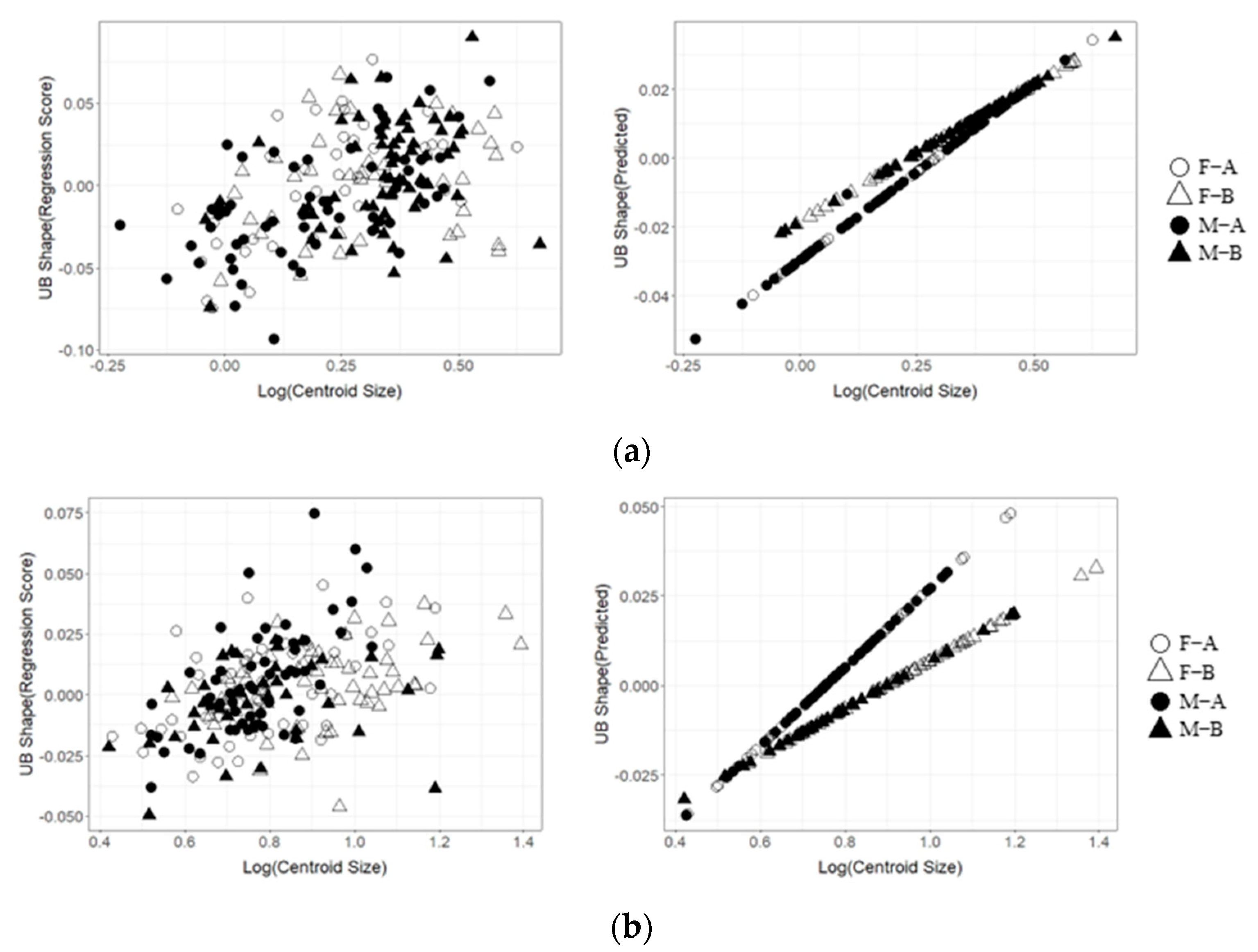
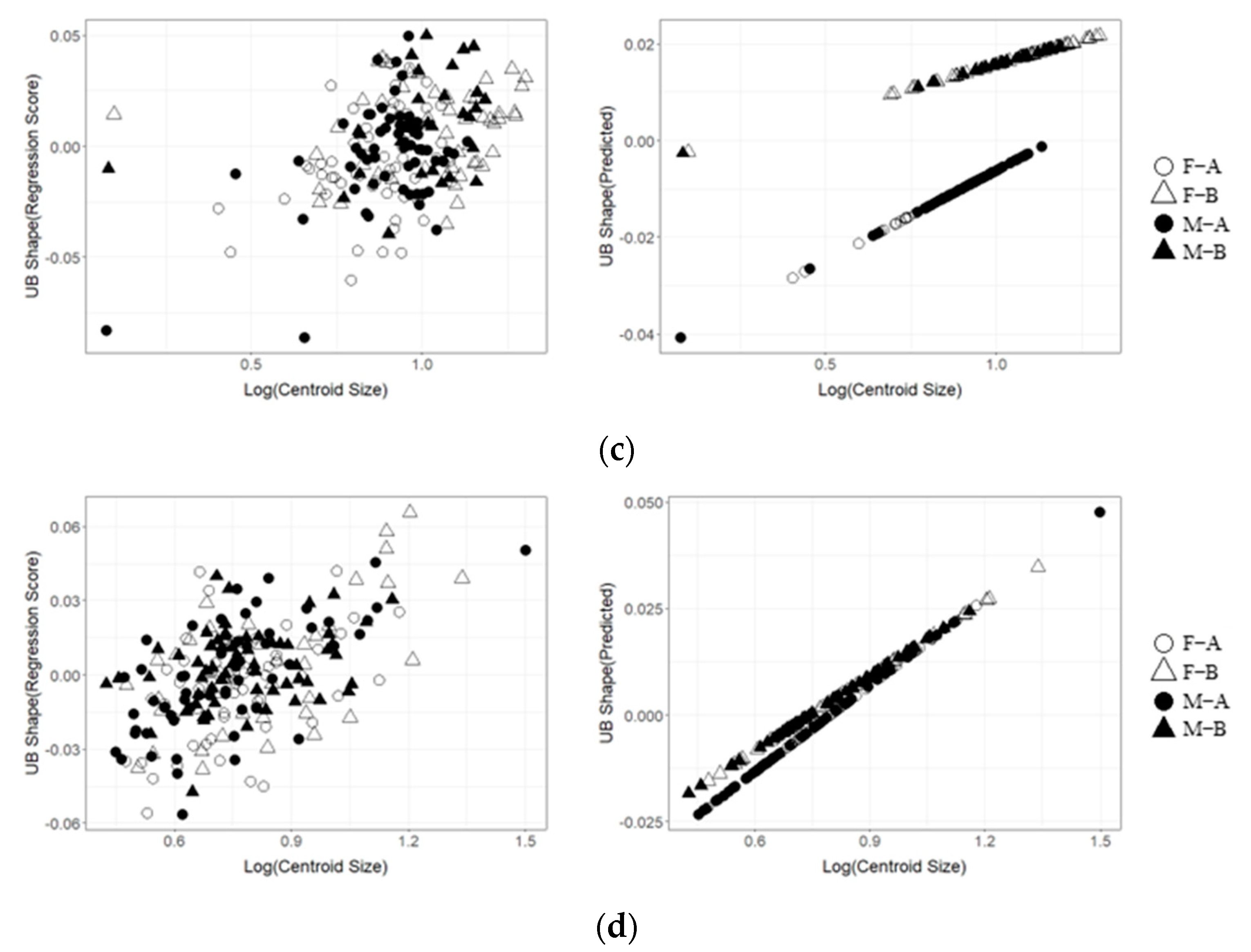
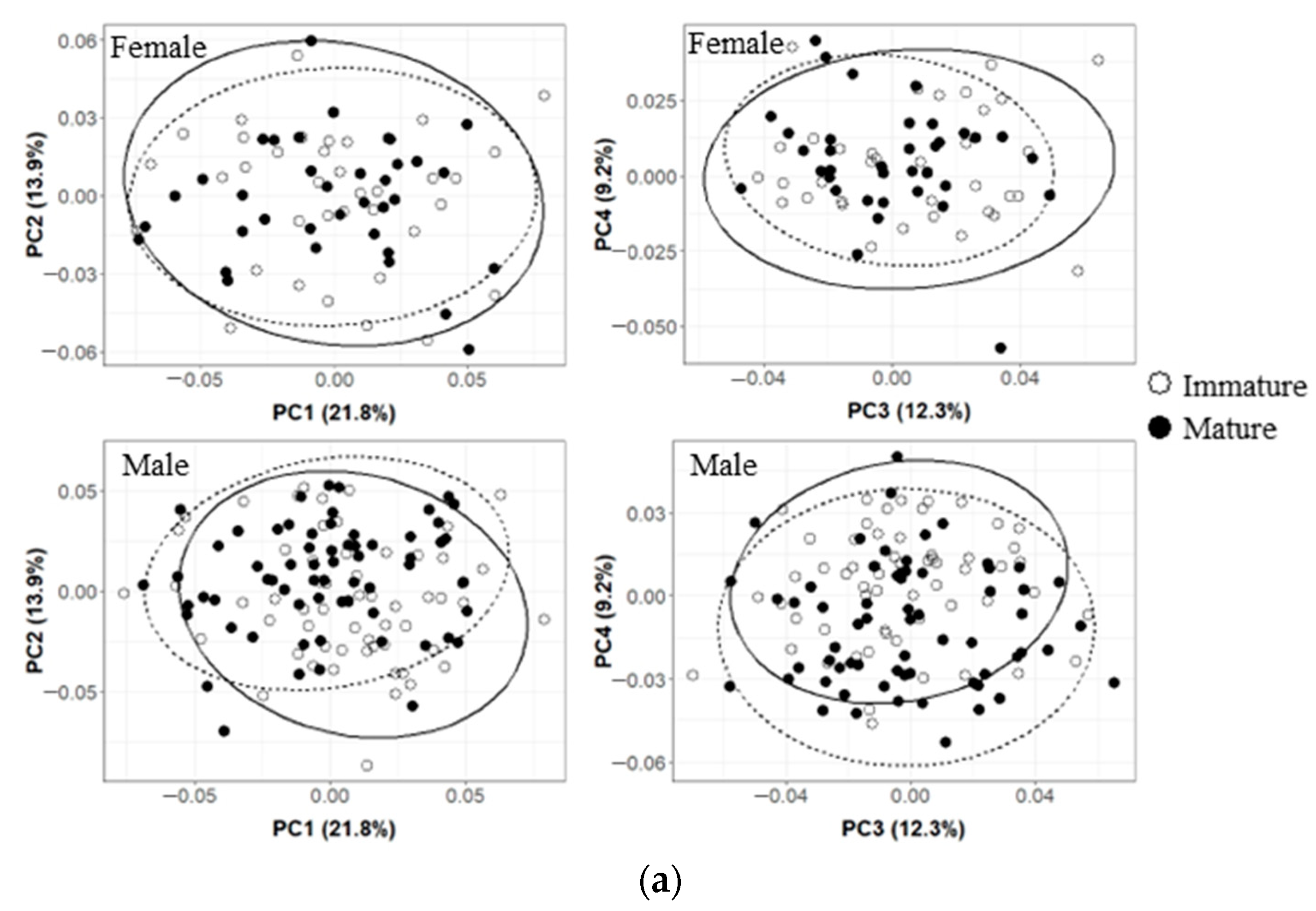
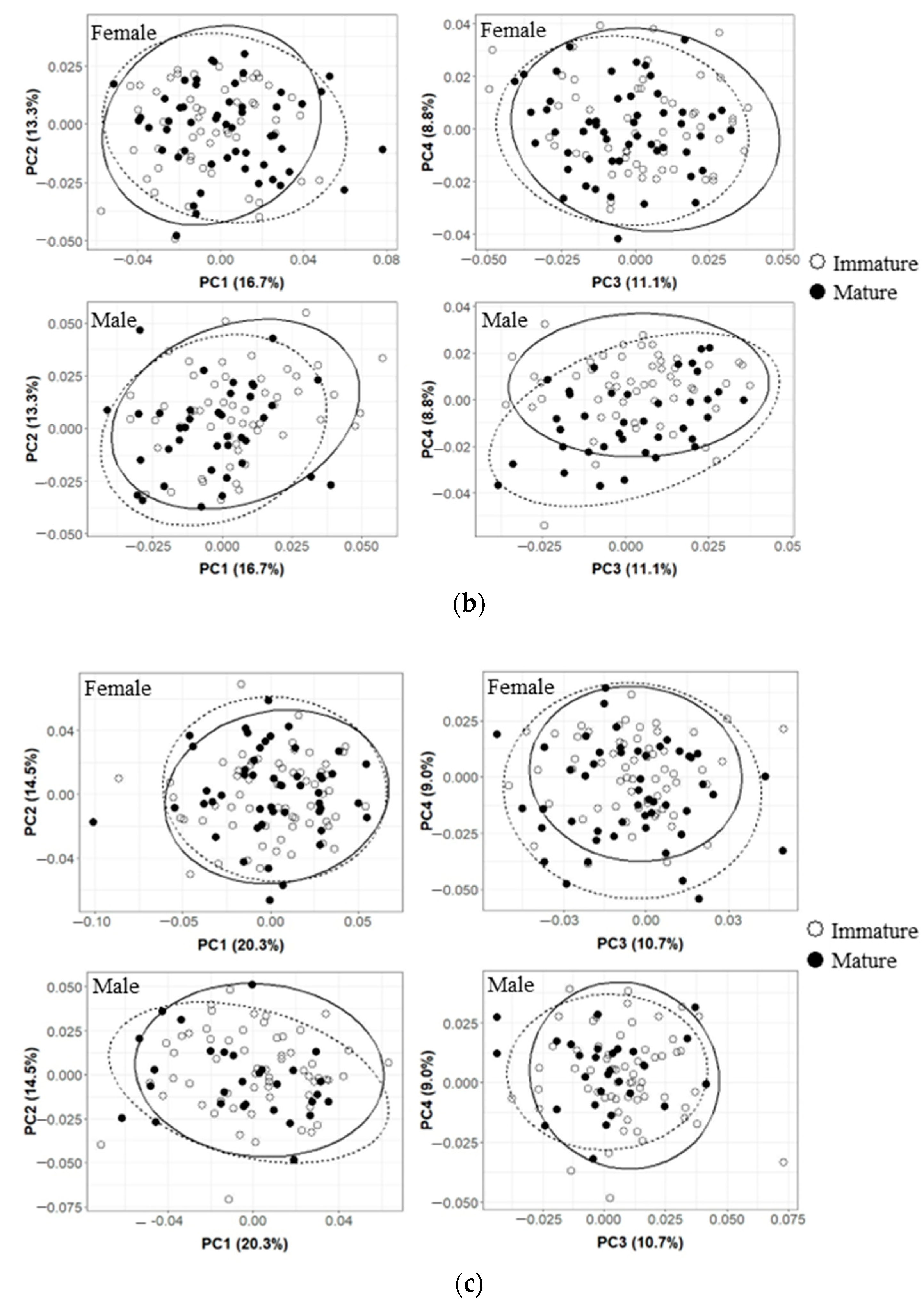
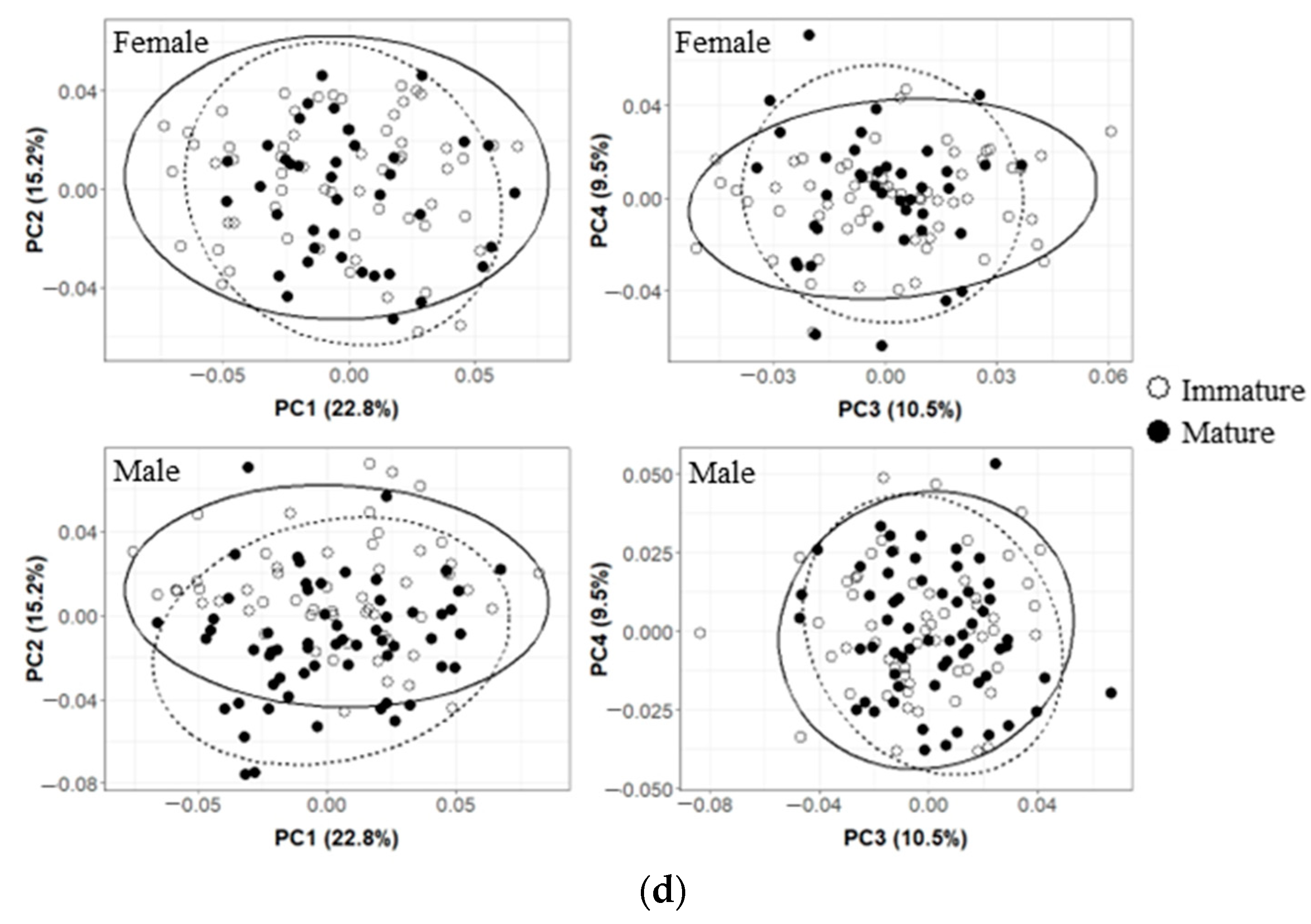
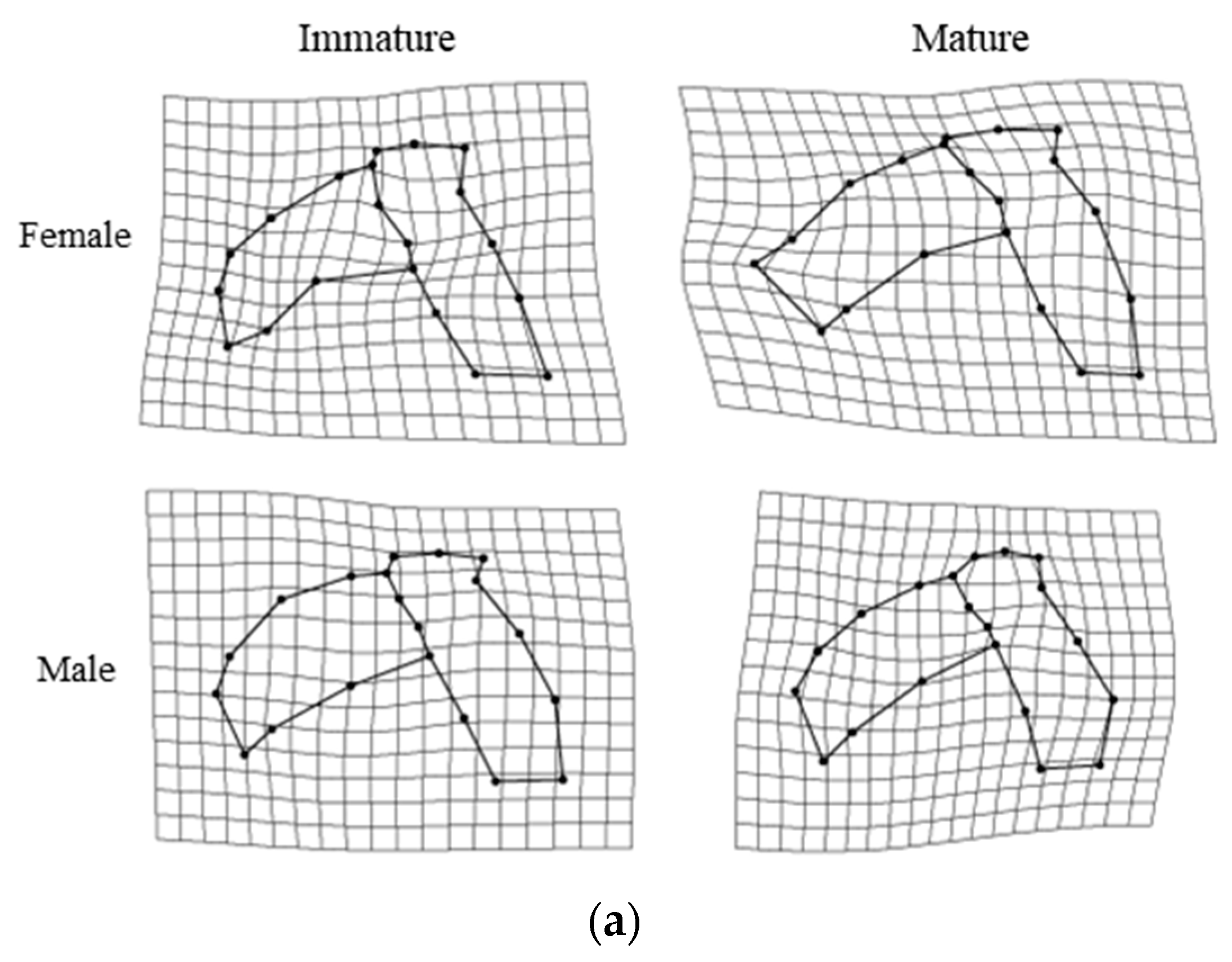
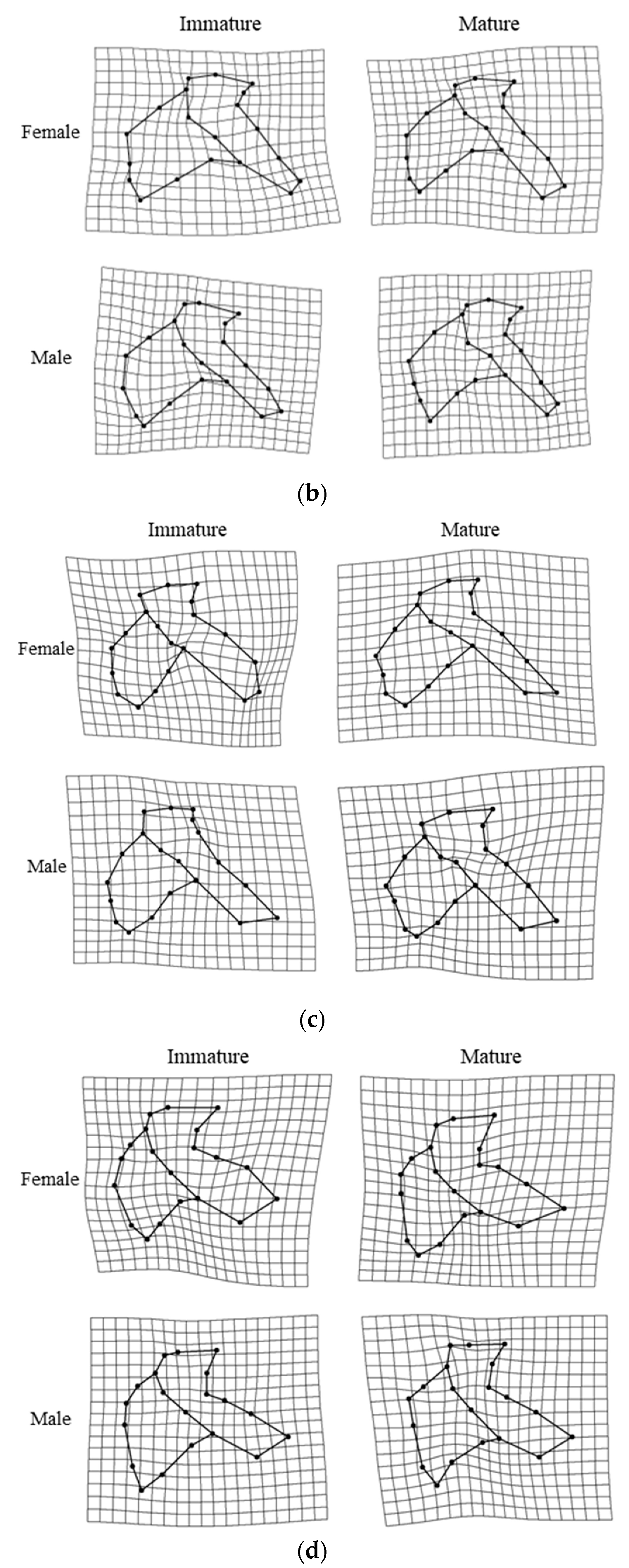
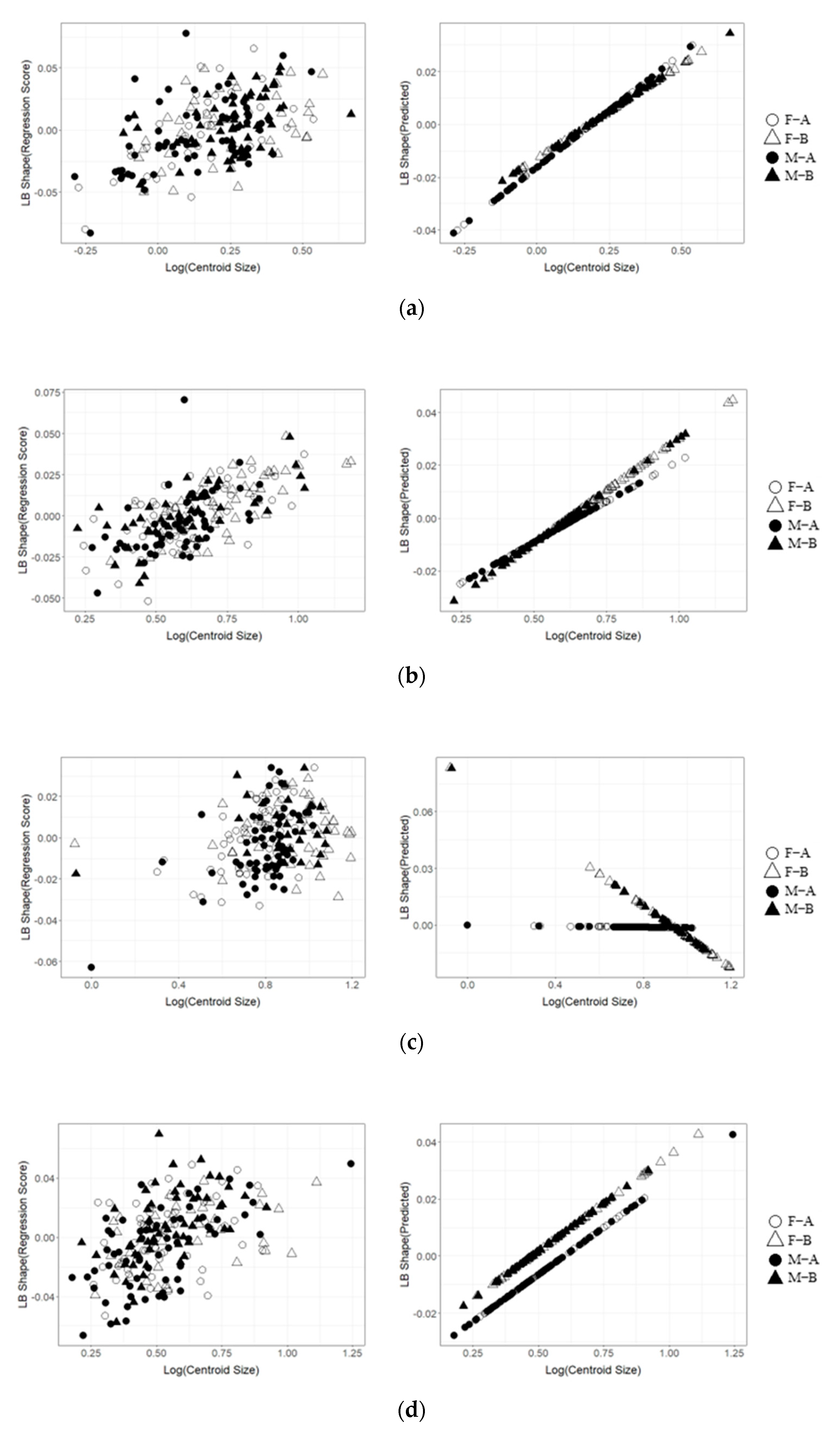
| Species | Ontogenetic Stages | Quantity of Samples (F, M) | Mantle Length (mm) (F, M) |
|---|---|---|---|
| Octopus minor | Immature | 97 (37, 60) | 16–69, 12–74 |
| Mature | 102 (39, 63) | 20–72, 20–79 | |
| Uroteuthis edulis | Immature | 110 (55, 55) | 92–190, 86–182 |
| Mature | 95 (53, 42) | 103–240, 100–232 | |
| Sepia esculenta | Immature | 120 (60, 60) | 51–129, 56–139 |
| Mature | 78 (49, 29) | 62–160, 63–154 | |
| Sthenoteuthis oualaniensis | Immature | 118 (60, 58) | 101–171, 100–189 |
| Mature | 100 (60, 40) | 104–296, 109–187 |
| Octopus minor | df | SS | MS | F | Z | p |
|---|---|---|---|---|---|---|
| Size | 1 | 0.0556 | 0.0556 | 10.9116 | 5.0287 | 0.001 |
| Ontogenetic stages | 1 | 0.0109 | 0.0109 | 2.1395 | 1.8142 | 0.035 |
| Sex | 1 | 0.0160 | 0.0160 | 3.1475 | 2.4676 | 0.009 |
| Size × ontogenetic stages | 1 | 0.0117 | 0.0117 | 2.2959 | 2.0383 | 0.024 |
| Size × sex | 1 | 0.0043 | 0.0043 | 0.8494 | −0.1484 | 0.549 |
| Ontogenetic stages × sex | 1 | 0.0079 | 0.0079 | 1.5491 | 1.1651 | 0.125 |
| Size × ontogenetic stages × sex | 1 | 0.0052 | 0.0052 | 1.0255 | 0.2676 | 0.385 |
| Residuals | 191 | 0.9726 | 0.0051 | |||
| Total | 198 | 1.0843 | ||||
| Uroteuthis edulis | df | SS | MS | F | Z | p |
| Size | 1 | 0.0335 | 0.0335 | 6.3105 | 3.4049 | 0.001 |
| Ontogenetic stages | 1 | 0.0134 | 0.0134 | 2.5257 | 2.4851 | 0.007 |
| Sex | 1 | 0.0103 | 0.0103 | 1.9345 | 1.9292 | 0.029 |
| Size × ontogenetic stages | 1 | 0.0108 | 0.0108 | 2.0415 | 1.5520 | 0.066 |
| Size × sex | 1 | 0.0159 | 0.0159 | 3.0031 | 2.1099 | 0.021 |
| Ontogenetic stages × sex | 1 | 0.0126 | 0.0126 | 2.3824 | 2.3226 | 0.012 |
| Size × ontogenetic stages × sex | 1 | 0.0127 | 0.0127 | 2.3879 | 1.8585 | 0.030 |
| Residuals | 197 | 1.0455 | 0.0053 | |||
| Total | 204 | 1.1548 | ||||
| Sepia esculenta | df | SS | MS | F | Z | p |
| Size | 1 | 0.0286 | 0.0286 | 8.3690 | 4.9628 | 0.001 |
| Ontogenetic stages | 1 | 0.0252 | 0.0251 | 7.3539 | 5.1175 | 0.001 |
| Sex | 1 | 0.0047 | 0.0047 | 1.3757 | 0.9843 | 0.172 |
| Size × ontogenetic stages | 1 | 0.0108 | 0.0108 | 3.1603 | 2.8167 | 0.003 |
| Size × sex | 1 | 0.0069 | 0.0069 | 2.0157 | 1.8508 | 0.038 |
| Ontogenetic stages × sex | 1 | 0.0019 | 0.0019 | 0.5642 | −1.1075 | 0.874 |
| Size × ontogenetic stages × sex | 1 | 0.0026 | 0.0026 | 0.7575 | −0.4160 | 0.661 |
| Residuals | 190 | 0.6497 | 0.0034 | |||
| Total | 197 | 0.7304 | ||||
| Sthenoteuthis oualaniensis | df | SS | MS | F | Z | p |
| Size | 1 | 0.0295 | 0.0295 | 8.9339 | 5.4394 | 0.001 |
| Ontogenetic stages | 1 | 0.0037 | 0.0037 | 1.1051 | 0.4886 | 0.318 |
| Sex | 1 | 0.0066 | 0.0066 | 1.9938 | 2.0165 | 0.021 |
| Size × ontogenetic stages | 1 | 0.0025 | 0.0024 | 0.7398 | −0.5531 | 0.698 |
| Size × sex | 1 | 0.0044 | 0.0044 | 1.3345 | 0.8517 | 0.190 |
| Ontogenetic stages × sex | 1 | 0.0048 | 0.0048 | 1.4396 | 1.1014 | 0.134 |
| Size × ontogenetic stages × sex | 1 | 0.0055 | 0.0055 | 1.6637 | 1.4738 | 0.068 |
| Residuals | 210 | 0.6941 | 0.0033 | |||
| Total | 217 | 0.7510 |
| Octopus minor | df | SS | MS | F | Z | p |
|---|---|---|---|---|---|---|
| Size | 1 | 0.0399 | 0.0399 | 7.5901 | 5.9824 | 0.001 * |
| Ontogenetic stages | 1 | 0.0069 | 0.0069 | 1.3162 | 0.8405 | 0.193 ns |
| Sex | 1 | 0.0091 | 0.0091 | 1.7232 | 1.5217 | 0.064 ns |
| Size × ontogenetic stages | 1 | 0.0066 | 0.0066 | 1.2474 | 0.7334 | 0.235 ns |
| Size × sex | 1 | 0.0064 | 0.0064 | 1.2192 | 0.7083 | 0.244 ns |
| Ontogenetic stages × sex | 1 | 0.0082 | 0.0082 | 1.5549 | 1.2435 | 0.114 ns |
| Size × ontogenetic stages × sex | 1 | 0.0066 | 0.0066 | 1.2623 | 0.7695 | 0.219 ns |
| Residuals | 192 | 1.0084 | 0.0053 | |||
| Total | 199 | 1.0919 | ||||
| Uroteuthis edulis | df | SS | MS | F | Z | p |
| Size | 1 | 0.0350 | 0.0350 | 10.1427 | 6.4009 | 0.001 * |
| Ontogenetic stages | 1 | 0.0070 | 0.0070 | 2.0207 | 1.9704 | 0.025 * |
| Sex | 1 | 0.0051 | 0.0051 | 1.4765 | 1.1945 | 0.133 ns |
| Size × ontogenetic stages | 1 | 0.0043 | 0.0043 | 1.2519 | 0.7994 | 0.210 ns |
| Size × sex | 1 | 0.0032 | 0.0032 | 0.9257 | −0.0621 | 0.523 ns |
| Ontogenetic stages × sex | 1 | 0.0084 | 0.0084 | 2.4245 | 2.4116 | 0.008 * |
| Size × ontogenetic stages × sex | 1 | 0.0063 | 0.0062 | 1.8112 | 1.7396 | 0.039 * |
| Residuals | 197 | 0.6793 | 0.0034 | |||
| Total | 204 | 0.7484 | ||||
| Sepia esculenta | df | SS | MS | F | Z | p |
| Size | 1 | 0.0196 | 0.0196 | 5.2965 | 4.2139 | 0.001 * |
| Ontogenetic stages | 1 | 0.0131 | 0.0131 | 3.5309 | 3.3474 | 0.001 * |
| Sex | 1 | 0.0094 | 0.0093 | 2.5219 | 2.2754 | 0.011 * |
| Size × ontogenetic stages | 1 | 0.0146 | 0.0146 | 3.9279 | 3.3226 | 0.001 * |
| Size × sex | 1 | 0.0043 | 0.0042 | 1.1461 | 0.5342 | 0.305 ns |
| Ontogenetic stages × sex | 1 | 0.0042 | 0.0042 | 1.1229 | 0.4810 | 0.320 ns |
| Size × ontogenetic stages × sex | 1 | 0.0075 | 0.0075 | 2.0309 | 1.7868 | 0.030 * |
| Residuals | 190 | 0.7044 | 0.0037 | |||
| Total | 197 | 0.7770 | ||||
| Sthenoteuthis oualaniensis | df | SS | MS | F | Z | p |
| Size | 1 | 0.0315 | 0.0315 | 6.7091 | 4.5043 | 0.001 * |
| Ontogenetic stages | 1 | 0.0111 | 0.0111 | 2.3571 | 2.0559 | 0.017 * |
| Sex | 1 | 0.0043 | 0.0043 | 0.9091 | −0.0141 | 0.502 ns |
| Size × ontogenetic stages | 1 | 0.0047 | 0.0047 | 0.9914 | 0.1859 | 0.435 ns |
| Size × sex | 1 | 0.0151 | 0.0151 | 3.2157 | 2.7576 | 0.002 * |
| Ontogenetic stages × sex | 1 | 0.0103 | 0.0102 | 2.1853 | 2.0485 | 0.024 * |
| Size × ontogenetic stages × sex | 1 | 0.0060 | 0.0060 | 1.2825 | 0.7839 | 0.226 ns |
| Residuals | 210 | 0.9850 | 0.0047 | |||
| Total | 217 | 1.0677 |
Disclaimer/Publisher’s Note: The statements, opinions and data contained in all publications are solely those of the individual author(s) and contributor(s) and not of MDPI and/or the editor(s). MDPI and/or the editor(s) disclaim responsibility for any injury to people or property resulting from any ideas, methods, instructions or products referred to in the content. |
© 2023 by the authors. Licensee MDPI, Basel, Switzerland. This article is an open access article distributed under the terms and conditions of the Creative Commons Attribution (CC BY) license (https://creativecommons.org/licenses/by/4.0/).
Share and Cite
Wang, C.; Fang, Z. Ontogenetic Variation and Sexual Dimorphism of Beaks among Four Cephalopod Species Based on Geometric Morphometrics. Animals 2023, 13, 752. https://doi.org/10.3390/ani13040752
Wang C, Fang Z. Ontogenetic Variation and Sexual Dimorphism of Beaks among Four Cephalopod Species Based on Geometric Morphometrics. Animals. 2023; 13(4):752. https://doi.org/10.3390/ani13040752
Chicago/Turabian StyleWang, Chao, and Zhou Fang. 2023. "Ontogenetic Variation and Sexual Dimorphism of Beaks among Four Cephalopod Species Based on Geometric Morphometrics" Animals 13, no. 4: 752. https://doi.org/10.3390/ani13040752
APA StyleWang, C., & Fang, Z. (2023). Ontogenetic Variation and Sexual Dimorphism of Beaks among Four Cephalopod Species Based on Geometric Morphometrics. Animals, 13(4), 752. https://doi.org/10.3390/ani13040752






